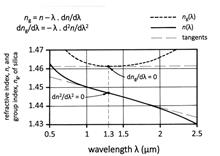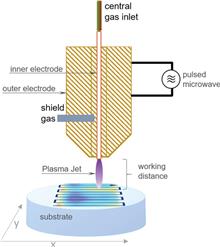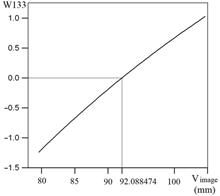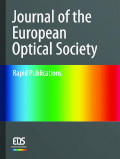Search by keywords or author
Journals >Journal of the European Optical Society-Rapid Publications
Export citation format
Research Articles
Comments about dispersion of light waves
Hervé C. Lefèvre
Dispersion of light waves is well known, but the subject deserves some comments. Certain classical equations do not fully respect causality; as an example, group velocity vg is usually given as the first derivative of the angular frequency ω with respect to the angular spatial frequency km (or wavenumber) in the mediumDispersion of light waves is well known, but the subject deserves some comments. Certain classical equations do not fully respect causality; as an example, group velocity vg is usually given as the first derivative of the angular frequency ω with respect to the angular spatial frequency km (or wavenumber) in the medium, whereas it is km that depends on ω. This paper also emphasizes the use of phase index n and group index ng, as inverse of their respective velocities, normalized to 1/c, the inverse of free-space light velocity. This clarifies the understanding of dispersion equations: group dispersion parameter D is related to the first derivative of ng with respect to wavelength λ, whilst group velocity dispersion GVD is also related to the first derivative of ng, but now with respect to angular frequency ω. One notices that the term second order dispersion does not have the same meaning with λ, or with ω. In addition, two original and amusing geometrical constructions are proposed; they simply derive group index ng from phase index n with a tangent, which helps to visualize their relationship. This applies to bulk materials, as well as to optical fibers and waveguides, and this can be extended to birefringence and polarization mode dispersion in polarization-maintaining fibers or birefringent waveguides.Dispersion of light waves is well known, but the subject deserves some comments. Certain classical equations do not fully respect causality; as an example, group velocity vg is usually given as the first derivative of the angular frequency ω with respect to the angular spatial frequency km (or wavenumber) in the medium, whereas it is km that depends on ω. This paper also emphasizes the use of phase index n and group index ng, as inverse of their respective velocities, normalized to 1/c, the inverse of free-space light velocity. This clarifies the understanding of dispersion equations: group dispersion parameter D is related to the first derivative of ng with respect to wavelength λ, whilst group velocity dispersion GVD is also related to the first derivative of ng, but now with respect to angular frequency ω. One notices that the term second order dispersion does not have the same meaning with λ, or with ω. In addition, two original and amusing geometrical constructions are proposed; they simply derive group index ng from phase index n with a tangent, which helps to visualize their relationship. This applies to bulk materials, as well as to optical fibers and waveguides, and this can be extended to birefringence and polarization mode dispersion in polarization-maintaining fibers or birefringent waveguides..
Journal of the European Optical Society-Rapid Publications
- Publication Date: Jun. 03, 2022
- Vol. 18, Issue 1, 2022001 (2022)
Generalized large optics fabrication multiplexing
Daewook Kim, Xiaolong Ke, Weslin Pullen, Tianyi Wang, Heejoo Choi, Vipender Singh Negi, Lei Huang, and Mourad Idir
High precision astronomical optics are manufactured through deterministic computer controlled optical surfacing processes, such as subaperture small tool polishing, magnetorheological finishing, bonnet tool polishing, and ion beam figuring. Due to the small tool size and the corresponding tool influence function, largeHigh precision astronomical optics are manufactured through deterministic computer controlled optical surfacing processes, such as subaperture small tool polishing, magnetorheological finishing, bonnet tool polishing, and ion beam figuring. Due to the small tool size and the corresponding tool influence function, large optics fabrication is a highly time-consuming process. The framework of multiplexed figuring runs for the simultaneous use of two or more tools is presented. This multiplexing process increases the manufacturing efficiency and reduces the overall cost using parallelized subaperture tools.High precision astronomical optics are manufactured through deterministic computer controlled optical surfacing processes, such as subaperture small tool polishing, magnetorheological finishing, bonnet tool polishing, and ion beam figuring. Due to the small tool size and the corresponding tool influence function, large optics fabrication is a highly time-consuming process. The framework of multiplexed figuring runs for the simultaneous use of two or more tools is presented. This multiplexing process increases the manufacturing efficiency and reduces the overall cost using parallelized subaperture tools..
Journal of the European Optical Society-Rapid Publications
- Publication Date: Jun. 03, 2022
- Vol. 18, Issue 1, 2022002 (2022)
Atmospheric Plasma Jet processing for figure error correction of an optical element made from S-BSL7
Heike Müller, Thomas Waak, Uwe Birnbaum, Georg Böhm, and Thomas Arnold
To meet the increasing market demand for optical components, Plasma Jet Machining (PJM) of Borosilicate Crown Glass (BCG), which can be an alternative to Fused Silica, is presented. Surface figure error correction was performed by applying reactive plasma jet etching, where a fluorine-containing microwave driven plasmaTo meet the increasing market demand for optical components, Plasma Jet Machining (PJM) of Borosilicate Crown Glass (BCG), which can be an alternative to Fused Silica, is presented. Surface figure error correction was performed by applying reactive plasma jet etching, where a fluorine-containing microwave driven plasma jet is employed to reduce the figure error in a deterministic dwell-time controlled dry etching process. However, some of the glass constituents of BCG cause the formation of a residual layer during surface treatment which influences the local material removal. By heating the substrate to about TS = 325 °C to 350 °C during processing, the etching behavior can clearly be improved. Geometric conditions of the optical element nevertheless lead to a characteristic temperature distribution on the substrate surface, which requires an adjustment of the local dwell times in order to obtain the required material removal. Furthermore, the resulting local surface roughness is also influenced by the surface temperature distribution. It is shown that figure error can be significantly reduced by taking the local temperature distribution and resulting local etching rates into account. A subsequent polishing step smoothens roughness features occurring during etching to provide optical surface quality.To meet the increasing market demand for optical components, Plasma Jet Machining (PJM) of Borosilicate Crown Glass (BCG), which can be an alternative to Fused Silica, is presented. Surface figure error correction was performed by applying reactive plasma jet etching, where a fluorine-containing microwave driven plasma jet is employed to reduce the figure error in a deterministic dwell-time controlled dry etching process. However, some of the glass constituents of BCG cause the formation of a residual layer during surface treatment which influences the local material removal. By heating the substrate to about TS = 325 °C to 350 °C during processing, the etching behavior can clearly be improved. Geometric conditions of the optical element nevertheless lead to a characteristic temperature distribution on the substrate surface, which requires an adjustment of the local dwell times in order to obtain the required material removal. Furthermore, the resulting local surface roughness is also influenced by the surface temperature distribution. It is shown that figure error can be significantly reduced by taking the local temperature distribution and resulting local etching rates into account. A subsequent polishing step smoothens roughness features occurring during etching to provide optical surface quality..
Journal of the European Optical Society-Rapid Publications
- Publication Date: Jul. 08, 2022
- Vol. 18, Issue 1, 2022003 (2022)
It is a sufficient condition only, not a necessary and sufficient condition, for decomposing wavefront aberrations
Psang Lin
The classic equation for decomposing the wavefront aberrations of axis-symmetrical optical systems has the form,(1)W(h0,ρ,ϕ)=∑j=0∝∑p=0∝∑m=0∝C2j+m2p+mm(h0)2j+m(ρ)2p+m(cosϕ)mwhere j, p and m are non-negative integers, ρ and ϕ are the polar coordinates of the pupil, and h0 is the object height. However, one non-zero compoThe classic equation for decomposing the wavefront aberrations of axis-symmetrical optical systems has the form,
Journal of the European Optical Society-Rapid Publications
- Publication Date: Jul. 06, 2022
- Vol. 18, Issue 1, 2022004 (2022)
Study of injection-locked stabilized, short cavity Brillouin ring laser source design for fiber sensing applications
Leonardo Rossi, Filippo Bastianini, and Gabriele Bolognini
A new pump-seeded, short-cavity Brillouin ring laser source layout intended for Brillouin sensing applications is showcased, showing increased high maximum output (1.5 mW), a strong linewidth narrowing effect (producing light with a linewidth of 10 kHz) and limited relative intensity noise (RIN ~ −145 dB/Hz), providingA new pump-seeded, short-cavity Brillouin ring laser source layout intended for Brillouin sensing applications is showcased, showing increased high maximum output (1.5 mW), a strong linewidth narrowing effect (producing light with a linewidth of 10 kHz) and limited relative intensity noise (RIN ~ −145 dB/Hz), providing an ultranarrow, highly stable BRL source that can also be employed as a pump-probe source for Brillouin optical time-domain analysis (BOTDA) applications.A new pump-seeded, short-cavity Brillouin ring laser source layout intended for Brillouin sensing applications is showcased, showing increased high maximum output (1.5 mW), a strong linewidth narrowing effect (producing light with a linewidth of 10 kHz) and limited relative intensity noise (RIN ~ −145 dB/Hz), providing an ultranarrow, highly stable BRL source that can also be employed as a pump-probe source for Brillouin optical time-domain analysis (BOTDA) applications..
Journal of the European Optical Society-Rapid Publications
- Publication Date: Aug. 12, 2022
- Vol. 18, Issue 1, 2022005 (2022)
Coherence onset in PT-symmetric organic microcavities: towards directional propagation of light
Karla Roszeitis, Markas Sudzius, Alexander Palatnik, Rebekka Koch, Jan Carl Budich, and Karl Leo
For the investigation of non-Hermitian effects and physics under parity-time (PT) symmetry, photonic systems are ideal model systems for both experimental and theoretical research. We investigate a fundamental building block of a potential photonic device, consisting of coupled organic microcavities. The coupled systemFor the investigation of non-Hermitian effects and physics under parity-time (PT) symmetry, photonic systems are ideal model systems for both experimental and theoretical research. We investigate a fundamental building block of a potential photonic device, consisting of coupled organic microcavities. The coupled system contains cavities with gain and loss and respects parity-time symmetry, leading to non-Hermitian terms in the corresponding Hamiltonian. Experimentally, two coupled cavities are realized and driven optically using pulsed laser excitation up to the lasing regime. We show that above the lasing threshold, when coherence evolves, the coupled-cavity system starts to operate asymmetrically, generating more light on one side of the device, being characteristic of non-Hermitian PT-symmetric systems. Calculations and simulations on a Su–Schrieffer–Heeger (SSH) chain composed of these PT-symmetric unit cells show the emergence of non-trivial topological features.For the investigation of non-Hermitian effects and physics under parity-time (PT) symmetry, photonic systems are ideal model systems for both experimental and theoretical research. We investigate a fundamental building block of a potential photonic device, consisting of coupled organic microcavities. The coupled system contains cavities with gain and loss and respects parity-time symmetry, leading to non-Hermitian terms in the corresponding Hamiltonian. Experimentally, two coupled cavities are realized and driven optically using pulsed laser excitation up to the lasing regime. We show that above the lasing threshold, when coherence evolves, the coupled-cavity system starts to operate asymmetrically, generating more light on one side of the device, being characteristic of non-Hermitian PT-symmetric systems. Calculations and simulations on a Su–Schrieffer–Heeger (SSH) chain composed of these PT-symmetric unit cells show the emergence of non-trivial topological features..
Journal of the European Optical Society-Rapid Publications
- Publication Date: Aug. 22, 2022
- Vol. 18, Issue 1, 2022006 (2022)
Optical characterization of strain sensing cables for Brillouin optical time domain analysis
Francesco Falcetelli, Filippo Bastianini, Pawel Bocheński, Leonardo Rossi, Raffaella Di Sante, and Gabriele Bolognini
Two innovative optical fiber cable layouts designed to improve strain measurement accuracy for Brillouin Optical Time Domain Analysis (BOTDA) sensors through improved strain transfer efficiency are presented and discussed. Swept Wavelength Interferometry (SWI) is used to experimentally evaluate their performance alongsTwo innovative optical fiber cable layouts designed to improve strain measurement accuracy for Brillouin Optical Time Domain Analysis (BOTDA) sensors through improved strain transfer efficiency are presented and discussed. Swept Wavelength Interferometry (SWI) is used to experimentally evaluate their performance alongside analytical models and numerical simulation through Finite Element Method (FEM). The results show good agreement between the different methods and show that the second sensing cable design presents good features to minimize the mismatch between measured and actual strain. Finally, the strain response of both strain and temperature sensing cables of this design are evaluated, showing that their difference in response is reliable enough to allow temperature compensation.Two innovative optical fiber cable layouts designed to improve strain measurement accuracy for Brillouin Optical Time Domain Analysis (BOTDA) sensors through improved strain transfer efficiency are presented and discussed. Swept Wavelength Interferometry (SWI) is used to experimentally evaluate their performance alongside analytical models and numerical simulation through Finite Element Method (FEM). The results show good agreement between the different methods and show that the second sensing cable design presents good features to minimize the mismatch between measured and actual strain. Finally, the strain response of both strain and temperature sensing cables of this design are evaluated, showing that their difference in response is reliable enough to allow temperature compensation..
Journal of the European Optical Society-Rapid Publications
- Publication Date: Aug. 25, 2022
- Vol. 18, Issue 1, 2022007 (2022)











